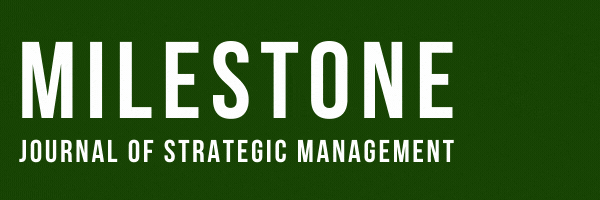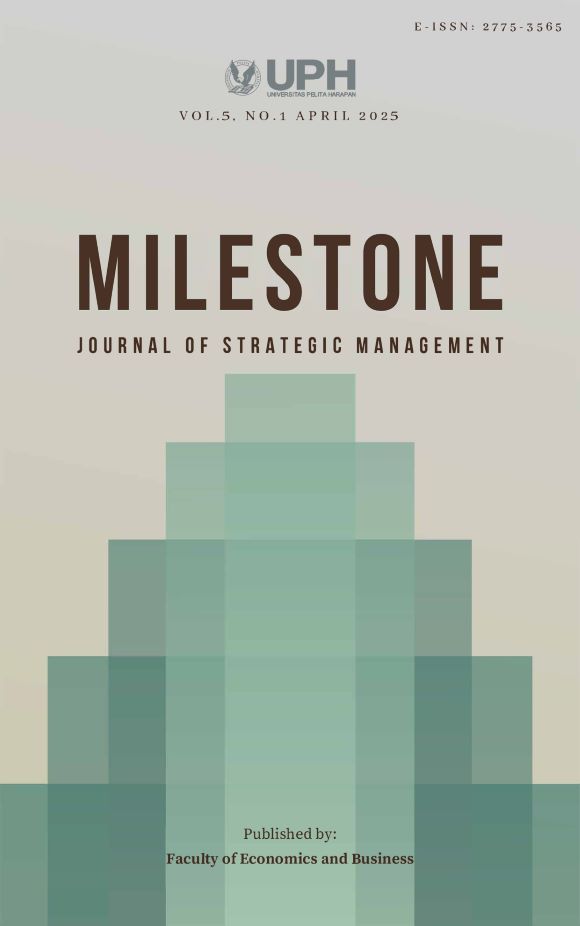FACTORS AFFECTING FINANCIAL DISTRESS: EVIDENCE FROM INDONESIA
DOI:
https://doi.org/10.19166/ms.v5i1.8607Kata Kunci:
Financial Distress, Profitability, Firm Size, Interest Expense, COVID-19Abstrak
This study analyzes the impact of various factors on financial distress in Indonesian companies, focusing on profitability, institutional ownership, firm size, firm age, interest expense, dividend payout, retained earnings, and the COVID-19 pandemic. The objective of the research was to understand the effects of those internal and external factors before crisis, during crisis and post crisis. Data from companies listed on the Indonesia Stock Exchange (excluding the financial sector) from 2013 to 2022. The numbers of the sample based on the criteria were 691 companies, which makes 6132 observation points in total as the sample for this research. The sample was analyzed using logistic regression to determine the relationship between these variables and financial distress. The study found that profitability significantly reduces the likelihood of financial distress, while firm size, firm age, high interest expenses, high retained earnings, and the COVID-19 pandemic significantly increase the likelihood of financial distress. Based on the findings, this study analyzed the impact of a company's condition during a crisis and the effect of external factors on the probability of financial distress and its impact on the company. The study can be used as a basis for company planning under external pressure conditions, considering the possibility of future events like pandemics or other crises.
Referensi
Adiwibowo, A. S., Rohmah, D. S., & Nurmala, P. (2023). The role of financial distress on company life cycle and stock return. JAK: Kajian Ilmiah Akuntansi, 10(2), 283–295. https://doi.org/10.30656/jak.v10i2.6222
Ali, I., Gohar, A., & Meharzi, O. (2017). Why do firms change their dividend policy?. International Journal of Economics and Financial Issues, 7(3), 411–422.
Altman, E. I., Hotchkiss, E., & Wang, W. (2019). Corporate financial distress, restructuring, and bankruptcy. Wiley Online Library. https://doi.org/10.1002/9781119541929.ch1
Anggraeni, T., Hady, H., & Nalurita, F.(2024). Financial distress, what factors affect it?. Gema Wiralodra, 15(1), 449–458. https://doi.org/10.31943/gw.v15i1.666
Antika, D. P., Fatekurohman, M., & Anggraeni, D. (2018). Analisis hubungan antara financial distress dan keputusan kebijakan dividen omisi perusahaan manufaktur. Journal Mathematics and Applications, 15(1), 41–54. http://dx.doi.org/10.12962/limits.v15i1.3390
Azizah, S., & Lismawati, L. (2024). The effect of financial performance on financial distress. Jurnal Ilmiah Akuntansi Kesatuan, 12(1), 167–178. https://doi.org/10.37641/jiakes.v12i1.2470
Brodeur, A., Gray, D., Islam, A., & Bhuiyan, S. (2021). A literature review of the economics of COVID-19. Journal of Economic Surveys, 35(4), 1007–1044. https://doi.org/10.1111/joes.12423
Bukhori, I., Kusumawati, R., & Meilani, M. (2022). Prediction of financial distress in manufacturing companies: Evidence from Indonesia. Journal of Accounting and Investment, 23(3), 588–605. https://doi.org/10.18196/jai.v23i3.15217
Chabachib, M., Kusmaningrum, R. H., Hersugondo, H., & Pamungkas, I. D. (2019). Financial distress prediction in Indonesia. WSEAS Transactions on Business and Economics, 16(1), 251–260.
Christy, V., & Natalylova, K. (2023). Pengaruh operating cash flow dan faktor pendukung lainnya terhadap financial distress. Media Bisnis, 15(1), 11–26. https://doi.org/10.34208/mb.v15i1.1812
Digdowiseiso, K., & Ningrum, I. S. (2022). The effects of total asset turnover, return on assets, and sales growth on financial distress in food and beverage companies over the period 2016-2020. Budapest International Research and Critics Institute (BIRCI-Journal): Humanities and Social Sciences, 5(2), 12046–12058. https://doi.org/10.33258/birci.v5i2.5042
Dirman, A. (2020). Financial distress: The impacts of profitability, liquidity, leverage, firm size, and free cash flow. International Journal of Business, Economics and Law, 22(1), 17–25.
Farooq, M., Hunjra, A. I., Ullah, S., & Al-Faryan, M. A. S. (2023). The determinants of financial distress cost: A case of emerging market. Cogent Economics and Finance, 11(1), 1–22. https://doi.org/10.1080/23322039.2023.2186038
Giovanni, S. A., & Djashan, I. A. (2023). Operating capacity, profitability, debt ratio, dan likuiditas berdampak kepada financial distress di masa pandemi COVID-19. Jurnal Manajemen TSM, 3(1), 1–14. http://dx.doi.org/10.34208/ejmtsm.v3i1.1885
Habibi, H. F., & Utami, W. (2022). Study of COVID-19 pandemic, financial ratios, and macroeconomic impact on financial distress in Indonesian manufacturing firms traded on the indonesian stock exchange. International Journal of Economics, Business, and Entrepreneurship, 5(2), 98–108. http://dx.doi.org/10.23960/ijebe.v5i2.202
Hafsari, N. A., & Setiawanta, Y. (2021). Analisis financial distress dengan pendekatan altman pada awal COVID-19 di Indonesia (studi empiris perusahaan transportasi dan logistik periode 2019). Jurnal Akutansi dan Pajak, 22(1), 394–403 http://dx.doi.org/10.29040/jap.v22i1.2309
Handriani, E., Ghozali, I., & Hersugodo, H. (2021). Corporate governance on financial distress: Evidence from Indonesia. Management Science Letters, 11, 1833–1844. https://doi.org/10.5267/j.msl.2021.1.020
Isayas, Y. N. (2021). Financial distress and its determinants: Evidence from insurance companies in Ethiopia. Cogent Business and Management, 8(1), 1–16. https://doi.org/10.1080/23311975.2021.1951110
Kieschnick, R., & Moussawi, R. (2018). Firm age, corporate governance, and capital structure choices. Journal of Corporate Finance, 48, 597–614. https://doi.org/10.1016/j.jcorpfin.2017.12.011
Lawal, J. J., Akinrinola, O. O., Ekperiware, C. M., & Ogbogbo, O. G. (2022). The impact of retained earnings on the financial growth of pension fund administrator (PFA) companies in Nigeria. CJSMS, 7(1), 54–78. https://doi.org/10.26772/CJSMS202
Li, Y., Li, X., Xiang, E., & Djajadikerta, H. G. (2020). Financial distress, internal control, and earnings management: Evidence from China. Journal of Contemporary Accounting and Economics, 16(3). 100–210 https://doi.org/10.1016/j.jcae.2020.100210
Manzaneque, M., Priego, A. M., & Merino, E. (2016). Corporate governance effect on financial distress likelihood: Evidence from Spain. Revista De Contabilidad-Spanish Accounting Review, 19(1), 111–121. https://doi.org/10.1016/j.rcsar.2015.04.001
Mayda, A., & Serly, V. (2021). Pengaruh karakteristik dewan direksi terhadap financial distress perusahaan BUMN di Indonesia tahun 2015-2019. Jurnal Eksplorasi Akutansi, 3(3), 567–582. https://doi.org/10.24036/jea.v3i3.427
Minanari, M. (2022). The influence of managerial ownership, profitability and leverage on financial distress (empirical study on property and real estate companies listed on the Indonesia stock exchange (IDX) 2016-2019). International Journal of Environmental, Sustainability and Social Sciences, 3(2), 351–358. http://dx.doi.org/10.38142/ijesss.v3i2.219
Mulekano, M. A., & MIROGA, J. (2023). Retained earnings and profitability of manufacturing firms listed at Nairobi securities exchange. Strategic Journal of Business & Change Management, 10(4), 163–173. https://doi.org/10.61426/sjbcm.v10i4.2741
Mulyaningsih, T., Cahyadin, M., & Sarmidi, T. (2021). Firms’ financial distress during the COVID-19 pandemic & fiscal incentives. Economic Research Institute for ASEAN and East Asia, 7, 1–7.
Paulina, G., & Ida, I. (2022). Prediksi kebangkrutan perusahaan penerbangan indonesia dengan metode Altman dan Springate. INOBIS: Jurnal Inovasi Bisnis dan Manajemen Indonesia, 5(2), 229–240. https://doi.org/10.31842/jurnalinobis.v5i2.226
Purwaningsih, E., & Safitri, I. (2022). Pengaruh profitabilitas, likuiditas, leverage, rasio arus kas dan ukuran perusahaan terhadap financial distress. JAE: Jurnal Akuntansi dan Ekonomi, 7(2), 147–156. https://doi.org/10.29407/jae.v7i2.17707
Rahman, F. (2022). Analisis prediksi finansial distress dengan metode Altman Z-Score dan Springate sebelum dan selama COVID-19. Journal of Education, Humaniora and Social Sciences, 5(1), 1–11. https://doi.org/10.34007/jehss.v4i4.1000
Ross, S. A., Westerfield, R., & Jordan, B. D. (2023). Essentials of corporate finance (11th ed.). McGraw Hill LLC.
Saputra, A. A., Prasetyo, T. J., & Idris, A. Z. (2022). Analysis of the effect of the COVID-19 pandemic crisis on financial distress “(empirical study on transportation companies listed on the BEI for the 2019 quarter 2 and 2020 quarter 2)”. Inovasi Pembangunan - Jurnal Kelitbangan, 10(1), 51–66. https://doi.org/10.35450/jip.v10i01.285
Serolin, A. (2023). Effect of corporate social responsibility, leverage, firm age and size on firm value. Research of Economics and Business, 1(2), 95–104. https://doi.org/10.58777/reb.v1i2.81
Sewpersadh, N. S. (2022). An econometric analysis of financial distress determinants from an emerging economy governance perspective. Cogent Economics and Finance, 10(1), 1–36. https://doi.org/10.1080/23322039.2021.1978706
The World Bank. (2021, Juni 17). Indonesia economic prospects: Boosting the recovery. https://www.worldbank.org/en/country/indonesia/publication/indonesia-economic-prospects-iep-june-2021-boosting-the-recovery
Yadav, I. S., Pahi, D., & Gangakhedkar, R. (2022). The nexus between firm size, growth and profitability: New panel data evidence from Asia–Pacific markets. European Journal of Management and Business Economics, 31(1), 115–140. https://doi.org/10.1108/EJMBE-03-2021-0077
Unduhan
Diterbitkan
Terbitan
Bagian
Lisensi
Hak Cipta (c) 2024 Tirza Chrissentia, Liza Handoko

Artikel ini berlisensiCreative Commons Attribution-ShareAlike 4.0 International License.
Authors who publish with this journal agree to the following terms:
1) Authors retain copyright and grant the journal right of first publication with the work simultaneously licensed under a Creative Commons Attribution License (CC-BY-SA 4.0) that allows others to share the work with an acknowledgement of the work's authorship and initial publication in this journal.
2) Authors are able to enter into separate, additional contractual arrangements for the non-exclusive distribution of the journal's published version of the work (e.g., post it to an institutional repository or publish it in a book), with an acknowledgement of its initial publication in this journal.
3) Authors are permitted and encouraged to post their work online (e.g., in institutional repositories or on their website). The final published PDF should be used and bibliographic details that credit the publication in this journal should be included.





